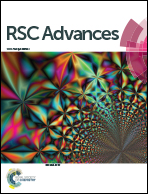A water soluble copper(ii) complex as a HSO4− ion selective turn-on fluorescent sensor applicable in living cell imaging†
Abstract
A water soluble non-fluorescent copper(II) complex (1) of a quinazoline derivative formulated as [Cu(L′)(Cl)] (1) has been synthesized via a facile synthetic method and characterized by physico-chemical and spectroscopic tools along with the single crystal X-ray crystallography for detailed structural analysis. 1 behaves as a highly selective and sensitive for HSO4− ions through the enhancement of fluorescence of the system based on intermolecular hydrogen bonding assisted chelation enhanced fluorescence (CHEF) process in ‘turn-on’ style, which has been confirmed by systematic optical techniques and electrochemical studies. This mode of sensing pathway and binding of HSO4− ions with the receptor 1 has also been validated by optimizing the structures of [Cu(L′)(Cl)] (1) and [Cu(L′)(Cl)]·HSO4− adduct (2) with the help of theoretical calculations. This non-cytotoxic probe senses HSO4− ions as low as 3.18 × 10−7 M in water : DMSO (9 : 1, v/v) at biological pH (using 1 mM HEPES buffer) and it is also useful for the detection of intracellular HSO4− ions under a fluorescence microscope.


 Please wait while we load your content...
Please wait while we load your content...